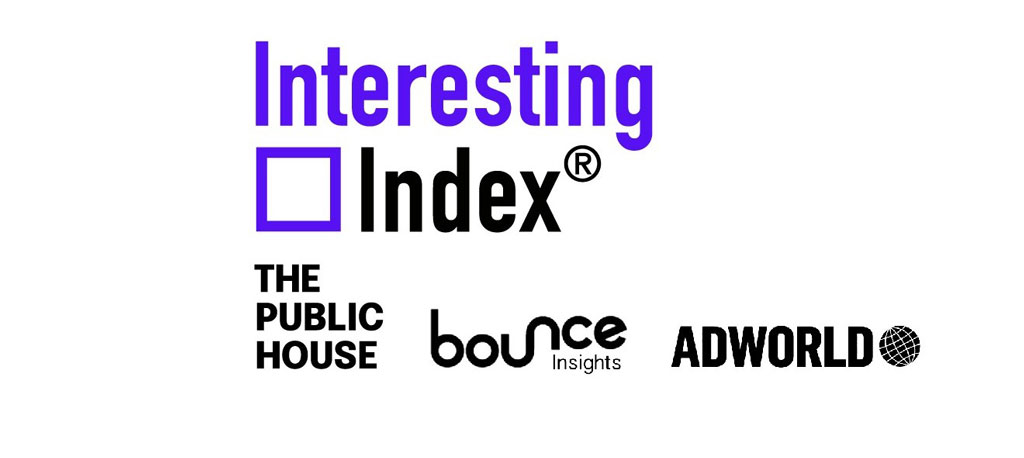 Following on from the launch of The Interesting Index – a collaboration between The Public House, Bounce Insights and Adworld.ie, Catriona Campbell wonders why so much advertising is ineffective and dull?
Following on from the launch of The Interesting Index – a collaboration between The Public House, Bounce Insights and Adworld.ie, Catriona Campbell wonders why so much advertising is ineffective and dull?
“Half the money I spend on advertising is wasted; the trouble is I don’t know which half.” John Wanamaker’s famous quote from the late 1800s has since been uttered by many marketers and has made its way on to thousands of PowerPoint presentations by eager students. Yet, it still feels more relevant than ever.
System 1 reported last week that 50% of the UK and US ads they test for creative effectiveness score a 1 star rating. That means those campaigns will have little to
No longer lasting brand effects, and that those campaigns elicit a very low, neutral or negative emotional response. System 1, based on this analysis, declared that at least 50% of advertising spend is wasted.
WARC has reported that up to 85% of advertising doesn’t even get noticed, failing to meet what they define as the ‘attention threshold’. The statistic, rooted in Karen Nelson-Field & Amplified Intelligence’s research of 130,000 ads, means that campaigns that fail to meet this attention threshold harm their capacity to enhance mental availability and reduce the likelihood of a brand coming to mind in a purchase situation.
That’s two of the seminal authorities on advertising effectiveness concluding that most (50-85%) of marketing and advertising investment is pretty much ineffective.

Ouch!
In Ireland, in 2023 alone companies will invest €1.43billion in advertising. Whether it’s 50% or 85% of that €1.43b, we are looking at eye watering figures in terms of wastage. When we look at this wastage against a backdrop of rising inflation where marketing budgets are under increasing pressure, this is, quite frankly, shocking.
If I was a CEO reading these stats, my reasoned temptation would be to pull back on my marketing budget. But – and it’s a big but – there is also empirical evidence on how to build effective campaigns. Peter Field sums this up by cautioning against the ‘cost of dull’. Andrew Tindall of System 1 declares that for advertising to be effective, it is ‘certain that we must entertain for commercial gain’. Adam Morgan, author of EatBigFish and founder of the ‘Let’s make this more interesting’ podcast implores us not to ‘bore’ our target audiences.
Research definitively tells us again and again that effective campaigns aren’t dull, but are entertaining. And research also points to how attributes like humour, music, jingles, brand characters, and celebrities, to name a few, can all contribute to this entertainment. In essence, we all have the effectiveness ‘playbook’, but if half of our campaigns are ineffective, we’re clearly not letting the effectiveness guardrails guide us.
Why is that? Is it that we’re still talking about ‘creative bravery’, when all the evidence here shows that the least risky marketing strategy is to embrace distinctiveness and stand out against the sea of same? Or is that for all the evidence, the creative development process, client side & agency side, is still rooted in gut instinct and subjectivity? Or could it be that as a united team, the marketing team and agency can’t reassure the SMT or the board about the pathway to take? Who knows the reasons – but what is certain is that no one sets out to make sub-par, ineffective work.
Here at The Public House, our view is that the concept of ‘dull’ can still be misunderstood or misconstrued, and is potentially a little vague and subjective. So, we’ve set out to help arm Irish marketers and agencies with clearer direction around what makes something ‘interesting’ – interesting being the opposite of ‘dull’.
And so The Public House, Bounce Insight and Adworld have created ‘The Interesting Index’. It works by trying to unpack what ads people remember and why. We believe that this proprietary research is the biggest Ireland-based qualitative study of its kind.
This study will run every two months for a minimum of six months and will ask people around Ireland which two ads (regardless of format) they recall from the previous two months and ask them to link those ads to an emotion. The emotions range from confused, bored, neutral, angry, happy, curious, surprised, annoyed, interested,
disgusted, excited, sad. But what makes this proprietary research so useful is the verbatim comments from our real world, ‘normal’, non-advertising people. We ask participants to describe each ad they remember: Who was it for, what was it about and what made you remember this ad?
The ambition of the Interesting Index is to help us all make advertising that is more creatively interesting, memorable, and ultimately, effective. We’re pretty much, as best we can, climbing into people’s brains to unpick and unpack what makes an ad memorable, with the hope that this insight and intelligence will help navigate us all away from the potential of ‘dull’.





















